Genuine Maturity of MAN and CAR
The challenge of the 24 Hours of Nürburgring
It all started in 2007.
The challenge was undertaken with the aim of developing people.
The team was comprised entirely of Toyota employees; its members were almost entirely new to the world of racing. Instead of debating what makes a good car in the confines of the office, the idea was for everybody to enter the race together and discuss it trackside.
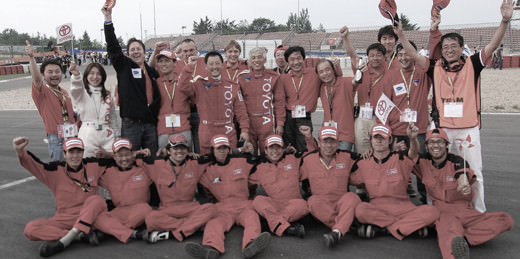
The Nürburgring in Germany was chosen as the battleground.
With a lap length of approximately 25 km, an elevation difference of 300 m or so between its highest and lowest points, and in excess of 170 corners of every variation, the Nürburgring is renowned as one of the world’s most difficult circuits. It is regarded as a proving ground for vehicle development, too.
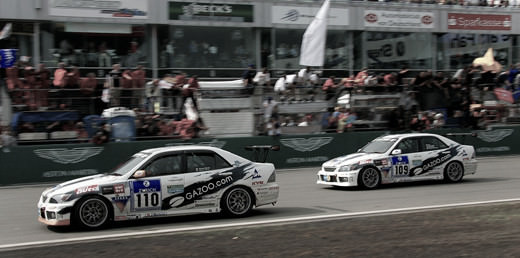
“What makes a ‘ever-better car?’”
By competing in an unforgiving race, and by competing in the real world where problems cannot be predicted, the team enhanced its approach to creating “durable cars.”
And the reason for participating in the 24 Hours of Nürburgring: to develop personnel who could go on to create ever-better cars.

What did Toyota gain from competing
in this most unforgiving of races?
Perfecting the prototype through racing
From the second year of competition onwards, Toyota GAZOO Racing amended its principle aim to “perfecting the LF-A prototype through racing before it launches.” Both Morizo and chief driver Hiromu Naruse competed in the race, alongside other drivers whose job it was to evaluate the cars. They left a host of data that contributed to development of the production vehicle.
There is no way of knowing what will happen during the race
Of course, unforeseen troubles occur: the Nürburgring is by no means tame. One year, the team stayed up through the night to change the engine. Many teams would retire in such circumstances, but the mechanics were steadfast in their desire “to find a way to see the car through to the finish line.” As a result, the team learnt how to respond to unexpected problems.
It is certainly the case that “people develop cars”; yet it is also true that “cars develop people.”
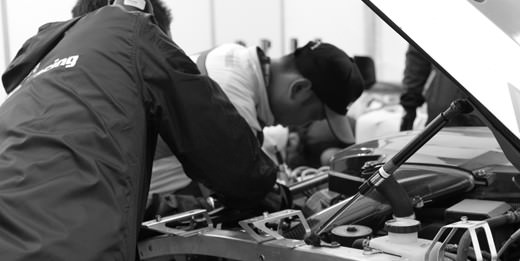
Genuine maturity of MAN and CAR can only be attained on the demanding roads.
The Toyota GAZOO Racing team members ordinarily worked on vehicle development, and so were almost complete novices when it came to racing.
At the beginning, the team frequently lost time during routine pit stops, but as they racked up the races, they became able to calmly complete tire, brake-rotor, and brake-pad changes within the time scheduled for refueling—this was a major improvement. When confronted with problems, the team learned to respond with speed and objectivity. Such developments were said to have even drawn praise from the professional mechanics of other teams.
The experience of the extreme conditions of the 24 Hours of Nürburgring is undoubtedly drawn upon when the team members return to their everyday jobs.
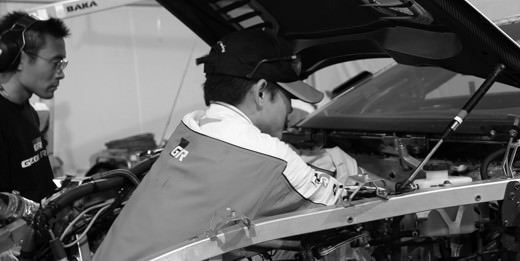
The 86 competes alongside the LFA
at the Nürburgring
Cars master the Nürburgring are competitive on any roads in the world
President Akio Toyoda stated, “Cars that prioritize performance must be developed at the Nürburgring. We entered the 86 into the 24 Hours of Nürburgring for this reason, just like we did with the LFA.”
At the race, though the 86 was often overtaken on the straights, it showed outstanding potential by performing on a par with cars in higher classes in sections with multiple corners. With exceptional balance, the car developed in such a way that its drivers could drive comfortably, with safety and enjoyment, even in the middle of the race.
The very same capabilities are demanded of production vehicles: and this was precisely the reason the 86 was perfected at the Nürburgring.
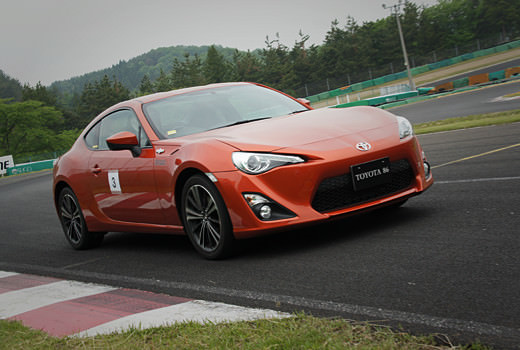
Victorious in three classes!
In addition to the LFA and 86, 2014 saw the arrival of the new, experimental prototype LFA Code X. Running trouble-free in both qualifying and the race itself, Toyota GAZOO Racing was victorious in three classes for the first time in its history.
The team, which had been a collection of novices just a few years earlier, had improved their teamwork and technical abilities. They demonstrated the skill required to deal with minor troubles within the timeframe of a routine pit stop.
However, this is by no means the finish line—on the contrary, it is the start of a journey to make “ever-better cars.”
![]()
In 2015, Toyota GAZOO Racing will enter two cars into the 24 Hours of Nürburgring: the LFA Code X, which competed last year, and the RC two-door coupe.
Racing is the ultimate stage on which to pass on technologies and train personnel.
What is important is not so much theorizing about car-making with words and data, but rather actually putting parts in their places, touching them with your hands, and understanding them with your eyes.
Hiromu Naruse, 2008.
Toyota GAZOO Racing will continue its race activities, for there is no finish line in making “ever-better cars.”





